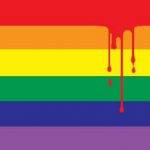(Updated May 2016)
Progress and Peace
If you read the Slovenia News & Reports page on this site, you will see a progressive country that has allowed civil partnerships since 2006. 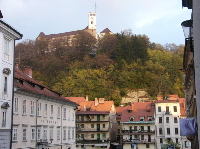 More recently, the Constitutional Court ruled that the country’s law on inheritance and succession discriminates same-sex couples and required that it be made equal.
More recently, the Constitutional Court ruled that the country’s law on inheritance and succession discriminates same-sex couples and required that it be made equal.
As long as the dominant straight Catholic population can buy their vegetables at the market, send their children to schools with traditional curricula and harvest their fertile pastures this pretty little state went about its historic way of life assuming all was well, especially since breaking away from communism with a short-lived ten day war of independence in 1991.
Alpine valleys here tumble down to chilly rushing rivers. Picturesque castles grace the countryside. Elections are orderly and trustworthy. Roads are well paved. But awkward issues such as human rights and sexuality are hardly noticed. A good loaf of bread seems more important.
Historic Problems
Then came February 2002 when a trio of guys ‘Sestre’ (sisters) decided to dress up as flight attendants, in bright red dresses, and sing a sweet song called ’Only Love’. Much to their amazement and delight they and their song were chosen as the representatives for Slovenia in the annual Eurovision Song Contest held each year.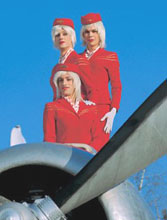
I didn’t know much about them. So the following comments are taken from ‘Slovenia for Gay Travelers’ web site (http://www.sloveniaforgaytravelers.com/):
“Sestre continued to be sweet and charming, appearing on talk shows and answering people’s questions with grace and dignity, as their upbeat song “Samo Ljubezen” (“Only Love”) soared to the top of the Slovenian charts… you couldn’t go ten minutes in Slovenia without hearing their song on the radio, or seeing them on billboards and television in campy ads for cell phones.”
“The controversy was painful at times for Slovenia’s small gay community, but Sestre eventually won over the people of Slovenia, and the gay community’s straight allies started speaking up. Almost overnight, thanks to Sestre, homosexuality became an open subject of discussion throughout the country.”
Needless to say, more than a few ‘good Slovenes’ were aghast that some drag queens were taking front stage for their modest homeland that had up to this point graciously avoided much discussion of homosexuality. Equally surprising was the flood of hostility aimed at the group that inevitably spread to homosexuals in general. (For more see report #5 in Slovenia News & Reports on this site)
But not everyone was surprised at the criticism. Gay activists had a list of dirty laundry that had accumulated over several years. In 2001 a serious book appeared that revealed media perpetuation of negative attitudes toward homosexuality from 1970 to 2000. In June 2001, a sort of Stonewall happened when a visiting Canadian poet, in all his flamboyance, and his host were denied entry at the non-gay 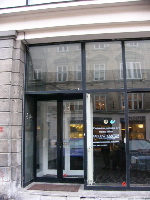 Café Galeria downtown near city hall (photo right). They were told “we don’t admit that kind of people here.”Out of that, a public protest was mounted to remind the citizens and government that homophobia was alive in Slovenia. (The point was made to some legislators as well who took notice and have helped lead pro-gay legislation through the thickets of parliament.)
Café Galeria downtown near city hall (photo right). They were told “we don’t admit that kind of people here.”Out of that, a public protest was mounted to remind the citizens and government that homophobia was alive in Slovenia. (The point was made to some legislators as well who took notice and have helped lead pro-gay legislation through the thickets of parliament.)
Also in 2001 a survey conducted by a gay activist group named SKUC-LL revealed high levels of discrimination against gay, lesbian and bisexual people in Slovenia. One of every two respondents had experienced some form of violence or harassment because of their sexual orientation, and one in five had suffered harassment at the workplace. (See report #4 in News & Reports on this site for more details.)
So pretty little Slovenia has some ugly weighty ghosts in its social closet. Although the fury has subsided now there is still work to be done against hostility and negativity toward LGBT Slovenes.
Today’s Ljubljana
On a recent Sunday morning in April 2016 Ljubljana the local church bells go off at 9 AM—all four churches at the same time in a rousing cacophony guaranteed to remind everyone in this ancient valley what day and time it was. Although not a particularly religious culture, the Slovenes do like their traditions which include church bells in beautiful antique belfries.
Ljubljana (pop. 278,000; whole country 2 million) is a very walkable city. My first night here I went from the train station to my hotel in less than ten minutes. Another ten minutes brought me to the chic and speedy Xplorer Cyber Café on the river for a couple of hours. Five minutes after leaving high tech I was in the 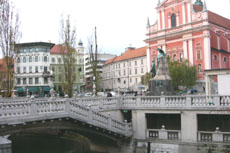 old town square with it densely charming mix of baroque, neo-classical and art deco buildings huddled around a cobblestone plaza named after a famous Croatian—not a great military hero set astride a bronze horse and brandishing a sword. Rather, this square is named after a 19th century poet whose visage faces across the storybook plaza toward a carved bust of his beloved fifty meters away.
old town square with it densely charming mix of baroque, neo-classical and art deco buildings huddled around a cobblestone plaza named after a famous Croatian—not a great military hero set astride a bronze horse and brandishing a sword. Rather, this square is named after a 19th century poet whose visage faces across the storybook plaza toward a carved bust of his beloved fifty meters away.
I entered Slovenia by train from Croatia. As the train snaked along the Sava River among forested mountains and verdant rural villages of farmers drying their hay and corn on kozolecs (hay racks with small roofs, found only in Slovenia) I felt I was passing through Austria. The houses were more polished and polite with colored stucco exteriors and tile roofs, as distinct from the more rustic and crude farmsteads in Croatia and Hungary.
Yards, gardens and pastures were cleaner with no piles of rubble or junk. The pastures seemed greener and the tractors newer. What a difference the absence of war can make. (Many rural Croatian villages were abandoned, burned, bombed and bullet-ridden when the ethnic Serbs were driven out by the native Croats during the wars of the 1990’s.)
After breaking with the former Yugoslavia and a brief ten-day war of independence the new government of Slovenia got down to business of putting the country on track to join the EU, which they did in 2004. Not that it will make a huge difference (except for an increase in prices and taxes): Slovenia has lived as close neighbors to Austria and Italy since ages past and the influence of the west is readily evident in the architecture and relative economic prosperity here (although still considerably less than in western Europe).
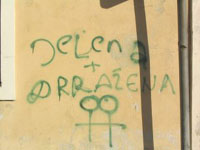 Despite the uproar about Sestre and the daunting news reports, as early as 1990 Slovenia approved constitutionally guaranteed rights and protections for minorities, including gays and lesbians. But abstract laws are one thing; the actions and attitudes of people in the street and in the media, as we have see, are quite another.
Despite the uproar about Sestre and the daunting news reports, as early as 1990 Slovenia approved constitutionally guaranteed rights and protections for minorities, including gays and lesbians. But abstract laws are one thing; the actions and attitudes of people in the street and in the media, as we have see, are quite another.
But during my visit I saw none of the negative behavior that has been reported about Slovenia’s homophobia. My impressions were of gays and lesbians living decent undisturbed lives—mostly because they were silent about their personal lives. However, the folks I saw and met were not in hiding either.
Surprise Introduction
My first night I Ljubljana I went to an ‘old world’ restaurant, the Sokol (Eagle) that served a delicious prix fixe menu of duck with sweet red cabbage and baked noodles—a once a year specialty served in honor of St Mark, so claimed the cheerful handsome waiter dressed in his traditional embroidered vest. As I sat there reading and watching hetero couples and foursomes dining, four young men arrived and took a table near me. Within a couple of minutes it was apparent to me they were gay.
I had been reading the SKUC-LL survey report entitled ‘Sexual Orientation Discrimination in Slovenia’, mentioned above. It was the first such survey of the extent and type of discrimination that homosexuals face in modern Slovenian life. The usual and unfortunate anecdotes of verbal slander, inhibited self-expression and a rare case of suicide are documented in the report. To read it is a sad and daunting reminder of the condition of human intolerance toward people who are different.
Musing on this I looked up to see quite a different scene in front of me at the chummy table of four–it was clear they were two gay couples out for an evening of camaraderie. The first ‘gay clue’ was their scrubbed and groomed look. Clear skin, shiny gelled hair, neat and casually stylish clothes. I had a private laugh to see how similar each couple was: sitting side by side each duo was dressed alike, two in zippered colored sporty tops (the ones with gelled hair) while opposite sat their friends both in long sleeve sweaters and buzz haircuts! (photo right)
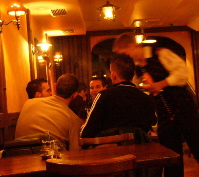 Another giveaway was the way they looked at each other, as friends and as lovers. Straight guys tend not to see their buddies with much subjectivity. These guys saw one another attentively and their responses were nuanced and connected to the feelings being felt and expressed. As their conversation warmed up over the course of the next hour with wine and good food they also touched each other with subtle and overt gestures. They leaned toward and against one another, resting an elbow on a partner’s shoulder for a moment or leaning across to take a bite of the others’ food.
Another giveaway was the way they looked at each other, as friends and as lovers. Straight guys tend not to see their buddies with much subjectivity. These guys saw one another attentively and their responses were nuanced and connected to the feelings being felt and expressed. As their conversation warmed up over the course of the next hour with wine and good food they also touched each other with subtle and overt gestures. They leaned toward and against one another, resting an elbow on a partner’s shoulder for a moment or leaning across to take a bite of the others’ food.
Returning from the restroom, one partner smoothly and lightly nuzzled the back of his lover’s neck with a slight kiss as he sat down. It was very quick, smooth and affectionate and he seemed to do it without the slightest hesitation or looking around. At one point one of the opposite partners stretched an arm behind his partner’s back and lightly caressed his lover’s neck with a finger as he brought his arm back to the table.
They toasted each other with wine and goblets at least half a dozen times, which I saw as validating their presence as full-parity citizens. They took some photos of each other with their cell phones and laughed at the results. Their conversation was punctuated with frequent laughter at what seemed an ongoing mix of in-jokes and catty remarks.
During the evening I noticed other customers (obviously straight in their baggy, less stylish clothes) toss glances at this happy friendship table; one guy, on his way to the rest room did a double-take to be sure he was seeing what he saw. Given the split-second dubious expression on his face I don’t think he considered inviting them for a beer with his soccer pals in another room of the restaurant. It was a silent victory, I thought, as these queers, in full and comfortable view of other couples enjoyed a safe evening of hearty food and warm friendship.
I laughed to myself again as I noticed the other couples were not nearly as animated or affectionate or expressive with their hetero mates. (Unfortunately, like many of the non-gay customers, two of the gay boys lit up cigarettes after dinner. So much for perfection!).
For me, their light-hearted evening was a glad tiding, a real-time counterpoint to the daunting social report on my table. All of them were in their upper twenties or early thirties. I saw them as the next generation of gay pride and courage with a firm sense of entitlement to ‘normal’ life as any citizen.
Of course these couples were not an accurate sample of gay Slovenia. This was in downtown Ljubljana on a rainy Saturday night. It was a moderately upscale restaurant—upstairs at least, downstairs was a bar café—and they seemed unusually bold. I doubt these guys had any activist agenda, and so much the better that they were not out to perform in public but rather to be who they were, to savor their friendships and be in love with their lovers. It was an excellent introduction to gay Slovenia.
Saturday Night Lively
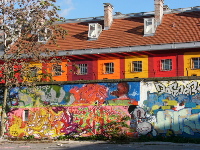
Later that night I wandered over to a very unusual section of the city called Metelkova, a sort of artists quarter where nearly a dozen bars, disco and clubs (gay and straight) come alive after dark in a frayed barracks building abandoned in the 90’s by the dissolving Yugoslavian army. One of Ljubljana’s two gay bar-discos, Tiffany, is tucked into one of the several buildings in the complex, nearly adjacent to a brightly colorful youth hostel housed in former prison (photo right).
Tiffany is a world-class name of fashion but here only the name is edgy. Tiffany bar has a rough and primitive feel–a single warehouse-style room with a small bar in one corner; the rest of the space open for dancing or just crowding in on the one busy night a week, Friday. The orange walls and blue ceiling are softened by the dimmed lighting, but the booming sound of music pulled my focus away from the appearance to the rhythm and beat of the place. The place is run on a small budget as evidenced by the ancient sound system the DJ was running.
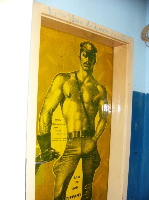 But Tiffany is not about being stylish. It’s here, alive and busy once a week for the Ljubljana gay community. Given that I was there on an off night and only a few people hung around suggested perhaps that gay folks here don’t need more than Friday out. The entry to Tiffany is unmistakable: the door is covered with a life-sized reproduction of a Tom of Finland drawing of a typical beefy guys in jeans and motorcycle cap sporting an oversized basket (photo left).
But Tiffany is not about being stylish. It’s here, alive and busy once a week for the Ljubljana gay community. Given that I was there on an off night and only a few people hung around suggested perhaps that gay folks here don’t need more than Friday out. The entry to Tiffany is unmistakable: the door is covered with a life-sized reproduction of a Tom of Finland drawing of a typical beefy guys in jeans and motorcycle cap sporting an oversized basket (photo left).
Immediately next door—ten feet away—is located the lesbian cafe-office-archive space of Monokel, which livens up on Friday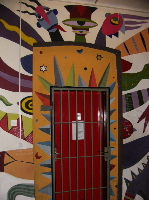 nights as well. It has a vividly abstract colorful entry that’s definitely not male oriented (photo right). Oddly (or perhaps not) there is a protective cage door that guards Monokel’s portal when it’s not open, which is most of the week.
nights as well. It has a vividly abstract colorful entry that’s definitely not male oriented (photo right). Oddly (or perhaps not) there is a protective cage door that guards Monokel’s portal when it’s not open, which is most of the week.
The biggest gay dance-drink scene takes place on Sunday nights at the Ljubljana University student union building, in the basement disco called K4. Gay night, called Roza Klub, is once a week and the place is packed with young men and women sipping beer, talking (shouting) over the music with friends, cruising, and dancing. There are two big separate dance floors each with its own DJ and particular sounds. I don’t’ know my disco music but one sounded very retro punk and the other more danceable with a pop beat.
Away From the Music and Smoke
But problems remain. Freedom and prosperity, parties and dancing, free enterprise and compulsory primary education don’t eradicate eons of cultural and religious prejudice. To combat such negative attitudes in Slovenia, there are several organizations that foster gay rights, pride and activism.
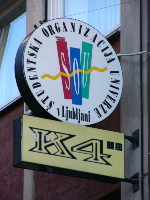 Despite the storm over Sestre, and false assumptions by most Slovenes, the gay and lesbian movement in Slovenia actually began as far back as 1984, when some LGBT folks decided to present the Magnus Festival that later evolved into the Ljubljana Gay and Lesbian Film Festival, now considered to be the oldest such festival in Europe. However, the film festival occurred mostly indoors and didn’t make much noise–even gay Slovenes don’t like to make much noise.
Despite the storm over Sestre, and false assumptions by most Slovenes, the gay and lesbian movement in Slovenia actually began as far back as 1984, when some LGBT folks decided to present the Magnus Festival that later evolved into the Ljubljana Gay and Lesbian Film Festival, now considered to be the oldest such festival in Europe. However, the film festival occurred mostly indoors and didn’t make much noise–even gay Slovenes don’t like to make much noise.
The most energetic organization is SKUC-LL, started in 1987, the first lesbian in communist eastern Europe. It was formed within the larger university Student Cultural and Artistic Union (SKUC) that was founded in 1972 to promote artistic freedom. SKUC-LL conducts both political and social functions. It lobbies for removal of all discrimination in both legal and public domain. The results of their work can be seen in the liberalization of Slovenian law that, in 2002, passed legislation recognizing same-sex couples and outlawing discrimination based on sexual discrimination.
Other sites and organizations (see links at left) are: SKUC-Magnus–the gay male counterpart of SKUC-LL . It too is a branch of the Students Cultural Center. DIH is the Slovenian Association for Integration of Homosexuality. Their work is education and advocacy for gay rights in Slovenia. ‘Out in Slovenia’ is a part of DIH and organizes outdoor activities such as hikes, trips and sporting events. Legebrita is a LGBT youth organization within the Ljubljana University Student Organization (SOU). GALfon is a phone hotline (7-10 PM) for LGBT. Two others groups are virtual and have web sites: Queer Resources Directory and SGS-Slovenian Gay Sites concerns.
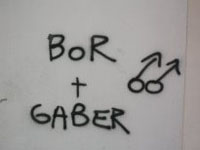 Not surprising, there is no LGBT Center location where social and support services are offered. The closest thing, by default, is the university student center that gives shelter to SKUC and is the venue for K4 Roza Klub on weekends..
Not surprising, there is no LGBT Center location where social and support services are offered. The closest thing, by default, is the university student center that gives shelter to SKUC and is the venue for K4 Roza Klub on weekends..
(By contrast, Romania’s second largest city, Kluj—about the size of Ljubljana–has a major university with no LGBT group on campus; the authorities do not allow it.)
Dinner with the Boys
To update gay life Ljubljana’s I had dinner one night in the quaint old town, at a boutique restaurant along a small cobblestone street lit with old lanterns. My hosts were two long–time activists, plus one boyfriend, from DIH, one of Ljubljana’s activists groups.
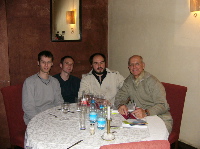 Andrej and Luka, (an economist and partner of Andrej for nineteen years) are handsome guys in their thirties who speak English nearly as fluently as their own Slovenian (most students here start English in the third grade).
Andrej and Luka, (an economist and partner of Andrej for nineteen years) are handsome guys in their thirties who speak English nearly as fluently as their own Slovenian (most students here start English in the third grade).
The work of all LGBT advocates was given a boost when Slovenia joined the European Union along with eight other countries (mostly former eastern communist countries). To become a member of this union, basic sets of economic policies, political standards and humanitarian legislation have to be in place within the legal system of a country.
EU anti-discrimination laws include sexual orientation as a protected and named category, along with a dozen others including race, religion and gender. But Slovenia was ahead of the EU directives in the field of employment legislation outlawing discrimination based on sexual orientation in 2002. Official recognition of LGBT partnerships did not come quickly in Slovenia. Finally in 2016 legislation was approved to give same-sex partnerships all rights of marriage, except adoption and in vitro fertilization.
(The EU left it up to each country how—and how strongly–to implement various human rights statutes. The EU regulations don’t say anything about the status of domestic partnerships or forms of registered partnerships. For example, Croatia (joined the EU in 2013) recognizes domestic partnerships but only allots same-sex couples two (out of the 58) rights allotted to married couples.)
The Slovene government is now more right of center than the previous ruling party, so further pro-gay legislation may be due for slow progress, said Mitja. (See News & Reports for some background on this legislation.)
On a more personal note, I asked the three men for their reaction to the two openly affectionate gay couples I observed in Sokol Restaurant two nights before. Mitja replied with two opposing opinions: “We do feel we have the freedom to be affectionate in Ljubljana, like these couples were, but I think we also get looks from others if we do. So most gays are not that courageous.”
Public Affections
Luka (who met Andrej through an ad) thought, why do it if it going to cause trouble, although he said that he has never experienced any homophobic attitudes or behavior directed at him. He admitted his reluctance was from his own internal homophobia.
Andrej countered his lover’s caution by saying, “but we do it!. When Luka and I are out I touch him and I lean toward him; I think he doesn’t realize it but I do. I think Slovenia is quite free about this.”
As a leading activist Andrej observed there is almost no gay bashing here. Only the rare event and then it’s in the area of bars where alcohol is consumed. Continued Andrej, “I have never felt threatened in all my life because I am gay. I go everywhere and I am visible with our activist work and I 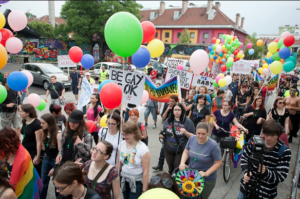 never feel at risk.
never feel at risk.
As further proof of Slovenia’s relative progressive nature Luca pointed out that the Pride Parade here happens without incident or reactions from conservatives (photo right). Few police are needed, unlike Serbia. The power of the church has been diminished; there are virtually no skinhead neo-Nazi gangs (although there are tiny pockets of anarchists whose ugly and illegal graffiti appears on city buildings at night). Andrej feels the situation is helped by a lot of western foreigners who live in Ljubljana and have more open minds. (See more about Ljubljana Pride.)
“But you know,” Luka continued “we Slovenes are not a society that shows strong opinions in public. Not like Croats or Serbs who will attack and yell at people they feel angry toward in the streets. We do it too but in private. We are more reserved that way. It also shows in that we also do not express much affection in public either,” as he looked around at the other restaurant patrons near us, all heterosexual couples, eating quietly with no one holding hands.
A further comment about LGBT couples
I told my hosts that in Berlin most gay relationships are valued and desired and often open to outside sex. Andrej observed that Ljubljana gay couples are mostly closed relationships but that lesbians appear to have more open relationships, possibly something to do feminist attitudes of not being owned or confined in their self-expression. Free choice is highly prized by lesbian women here, he thought.
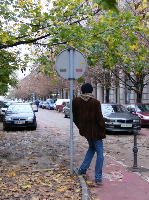 There are of course many gay guys who don’t want to be in a primary relationship, who can be seen cruising various venues in town such as Tivoli Park or the swimming pool at the Tivoli Recreation Center. There is a sauna also in the park which gays can visit.
There are of course many gay guys who don’t want to be in a primary relationship, who can be seen cruising various venues in town such as Tivoli Park or the swimming pool at the Tivoli Recreation Center. There is a sauna also in the park which gays can visit.
Another observation by Andrej is a quasi-myth that gays over thirty disappear in Ljubljana since there is no place for them to go; the discos are for young people and there are no clubs for older gays. He also said he does not know any long term older couples. No doubt they are there but that generation tends to be much more closeted.
All the parents of my hosts know about and accept their homosexuality, after the usual period of adjustment for the parents. Both Andrej and Luka recently bought a house together. Ljubljana is very expensive for apartment rentals; $800-1000 a month for rent is equal to a months pay for most.
So it’s not unusual for European young people in their twenties to continue living with their family until they marry or can afford an apartment with their partner or spouse. However, Mitja has a good job as a radio journalist (with “medium” pay) and lives with his partner Viki, a computer consultant, in their own flat. Last year Luka and Andrej bought their own house on the outskirts of Ljubljana which they are very pleased and proud of.
Cruising the Net
Another accidental moment came as I was accessing my e-mail at Xplorer Internet shop one evening by the river that flows through central Ljubljana. I found out where the over-30 set go for a night out: a guy in his late thirties sat down at the computer next to me and proceeded to hook into Gaydar.com. The pictures this guy was bringing up were quite explicit in various seductive poses.
 He was doing it within full view of the rest of the Internet shop, although he was at a computer at the end of a row. But he didn’t look around to see who might be looking or if I was watching—which I was, sort of!
He was doing it within full view of the rest of the Internet shop, although he was at a computer at the end of a row. But he didn’t look around to see who might be looking or if I was watching—which I was, sort of!
The ease and comfort he expressed were disarming and encouraging. He interacted with some guys and sent his mobile phone number. When it rang he replied and muttered something in Slovenian and left a short while later. He went to ‘that place’, wherever it was, for the over-30s after 9 PM on a chilly night in Ljubljana.
By the way, there is free Internet connection at Ljubljana University Student Center. A visitor can use one of the many computers there or bring their own computer if it’s equipped with WiFi.
Gay Bowling night in Slovenia
Wednesday is gay bowling night at the local lanes, a big shiny venue with about twenty lanes and a bar lounge. Eight of us took over four lanes for a couple of hours and tossed our gaily colored balls down the middle, the sides and the gutters of the alleys. It was not a competition but more a chance to chat and meet with friends, old and new. I met a ballet dancer, a waiter, a foreign service intern from Canada, a drug rehab counselor, a computer database engineer/writer and an orthopedic surgeon.
I asked the Canadian, a handsome blonde who seemed a bit shy but still friendly, to comment on his experiences here as a outsider finding his way in gay Ljubljana. “I have found it’s not easy to access gay people here. 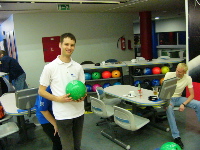 There are so few gay venues and I don’t really like bars that much. I’ve been here for two months and have only gone to K4 and Tiffany once. I don’t know where to find the community. The people here (at bowling) know each from being activists but there are not many of them. There are a lot of LGBT people in this city but there is no ‘gay area’ or gay center like Toronto (his home). They seem dispersed throughout the city. Maybe that’s a good thing and there’s no need for a ghetto to build a identifiable community. But for an outsider it’s not easy.”
There are so few gay venues and I don’t really like bars that much. I’ve been here for two months and have only gone to K4 and Tiffany once. I don’t know where to find the community. The people here (at bowling) know each from being activists but there are not many of them. There are a lot of LGBT people in this city but there is no ‘gay area’ or gay center like Toronto (his home). They seem dispersed throughout the city. Maybe that’s a good thing and there’s no need for a ghetto to build a identifiable community. But for an outsider it’s not easy.”
To add to his frustration, he added that he can’t recognize gay people on the streets “because body language and clues don’t’ seem the same as in Canada where street gaydar is more obvious. But gay people here say they can easily tell who’s who on the streets. So it must be a whole different sets of clues that I don’t get.”
I recalled Andrej’s comments over dinner about the relatively settled life that gays have here in Slovenia. They live a low profile life with only a few occasions for flag-waving and parading. There is no urgent activist agenda pushing through the courts with lawsuits on behalf of aggrieved couples who want to marry.
Political lobbying is mostly done in quiet backroom conversations, however to make a louder statement on occasion DIH has successfully organized public protests, one of them featuring Mitja wearing a national costume, handing out spices to politicians. (The spices in question were actually used in the Middle Ages when burning homosexuals.)
Legislation is being slowly formulated to further authenticate domestic partnerships. As well, there are no right wing or religious conservative forces gathered at the gates of Sodom here condemning LGBT life styles and proclaiming our “inherent moral evil” from evangelical pulpits. The lack of an organized, vocal and strident enemy has the effect of keeping gays out of the spotlight or hot seat, unless you’re a ‘Sestre’.
Today there is domestic partnership registration. In a conversation a few days later on our way to astonishing  Predjama Castle (photo right) built into the mouth of a mammoth mountain cave southeast of Ljubljana (we drove through a light snow storm on our way), I was told me that he and his friends were pleased with the partnership bill that allows same-sex couples nearly all the same rights as hetero couples except for adoption and in vitro fertilization; they cannot have a an official (church or civil) ceremony.
Predjama Castle (photo right) built into the mouth of a mammoth mountain cave southeast of Ljubljana (we drove through a light snow storm on our way), I was told me that he and his friends were pleased with the partnership bill that allows same-sex couples nearly all the same rights as hetero couples except for adoption and in vitro fertilization; they cannot have a an official (church or civil) ceremony.
Of course they can create any private ritual they desire. But gay leaders are of course not satisfied with the truncated rights but they are also pragmatic and are patiently waiting for their next move before pressing for full equality.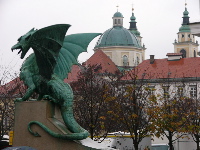 “We are making good progress. Our leaders don’t mind being pushed to new things so we have to do it slowly of course so they don’t feel like it’s too far.”
“We are making good progress. Our leaders don’t mind being pushed to new things so we have to do it slowly of course so they don’t feel like it’s too far.”
Given the steady progress Slovenia has made economically, politically and for human rights since it’s independence from socialist Yugoslavia, this little country is opening to a brighter future.
Also see:
Gay Slovenia News & Reports 2000 to present
Gay Slovenia Photo Galleries

